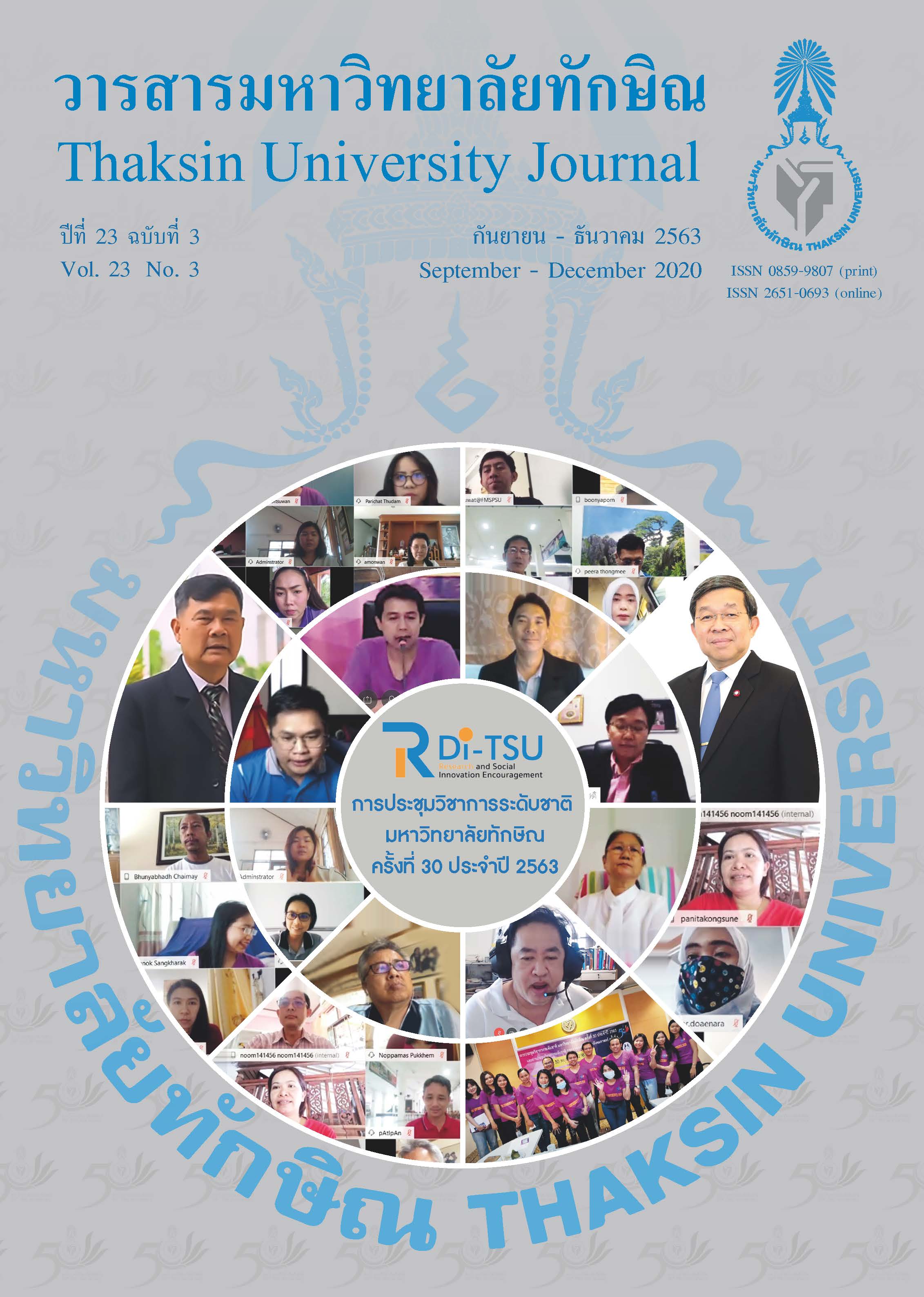ผลของไคโตซานต่อการเจริญเติบโตของมะเขือเทศสีดาในระยะวัฒนภาค
Main Article Content
บทคัดย่อ
ไคโตซานเป็นไบโอโพลีเมอร์ที่สามารถนำมาประยุกต์ใช้กับวงการเกษตรกรรมหลากหลายด้าน เช่น ส่งเสริมการเจริญเติบโตและเพิ่มปริมาณผลผลิตของพืชจากเหตุผลดังกล่าวจึงนำมาสู่วัตถุประสงค์ของงานวิจัยเพื่อศึกษาผลของไคโตซานต่อการส่งเสริมการเจริญเติบโตของตน้ มะเขือเทศสีดาในระยะวัฒนภาคและศึกษาผลของสารละลายไคโตซานที่ความเข้มข้นต่าง ๆ ต่อการเจริญเติบโตของต้นมะเขือเทศโดยวางแผนการทดลองแบบสุ่มตลอด ผลการทดลองแสดงให้เห็นว่าสารละลายไคโตซานที่ความเข้มข้น 0.5-1.5 มิลลิกรัมต่อมิลลิลิตร ไม่มีผลต่อขนาดเส้นผ่าศูนย์กลางของลำต้นแต่ส่งผลต่อจำนวนใบ ความสูง น้ำหนักแห้ง ปริมาณคลอโรฟิลล์และอัตราการเจริญเติบโตสัมบูรณ์สารละลายไคโตซานที่ความเข้มข้น 0.5 มิลลิกรัมต่อมิลลิลิตร สามารถส่งเสริมการเจริญเติบโตไดดี้ที่สุด โดยจำนวนใบ น้ำหนักแห้งราก และน้ำหนักแห้งของต้นของมะเขือเทศ เพิ่มสูงขึ้นร้อยละ 32 77.6 และ 41.8 ตามลำดับ เมื่อเทียบกับชุดควบคุม นอกจากนั้นปริมาณคลอโรฟิลล์ทั้งหมดในใบมะเขือเทศที่ทดสอบด้วยสารละลายไคโตซานยังเพิ่มสูงขึ้น 8-12 เปอร์เซ็นต์ เมื่อเปรียบเทียบกับชุดควบคุม
Article Details

This work is licensed under a Creative Commons Attribution-NonCommercial-NoDerivatives 4.0 International License.
References
Frusciante, L., Carli, P., Ercolano, M. R., Pernice, R., Di Matteo, A., Fogliano, V., & Pellegrini, N. (2007). Antioxidant nutritional quality of tomato. Molecular Nutrition & Food Research, 51(5), 609–617. https://doi.org/10.1002/mnfr.200600158.
Ekpong, B. (2014). A new, open-pollinated processing tomato, UBU 406. Journal of Science and Technology, 16(1), 76–82.
Office of Agricultural Economics. (2020). Agricultural economic information (Online). Retrieved June 1, 2020, from http://www.oae.go.th/view/1/ขอ้ มูลการผลิตสินคา้ เกษตร/TH-TH.
Noiket, N., Boonthip, T., & Riangwong, K. (2014). Evaluation of potential for chitosan to control TYLCV disease and promote the growth of Sridathip 3 tomato. In The 26th Annual Meeting of the Thai Society for Biotechnology and International Conference, 252–259. November 26–19, 2014. Chiang Rai: Mae Fah Luang University, Thailand.
Benhamou, N., Kloepper, J. W., & Tuzun, S. (1998). Induction of resistance against Fusarium wilt of tomato by combination of chitosan with an endophytic bacterial strain: ultrastructure and cytochemistry of the host response. Planta, 204(2), 153–168. DOI: https://doi.org/10.1007/s004250050242.
Mishra, S., Jagadeesh, K. S., Krishnaraj, P. U., & Prem, S. (2014). Biocontrol of tomato leaf curl virus (ToLCV) in tomato with chitosan supplemented formulations of Pseudomonas sp. under field conditions. Australian Journal of Crop Science, 8(3), 347–355.
Boonlertnirun, S., Boonraung, C., & Suvanasara, R. (2008). Application of chitosan in rice production. Journal of Metals, Materials and Minerals, 18(2), 47–52.
Ghoname, A. A., El-Nemr, M. A., Abdel-Mawgoud, A. M. R., & El-Tohamy, W. A. (2010). Enhancement of sweet pepper crop growth and production by application of biological, organic and nutritional solutions. Journal of Agriculture and Biological Sciences, 6(3), 349–355.
Akter Mukta, J., Rahman, M., As Sabir, A., Gupta, D. R., Surovy, M. Z., Rahman, M., & Islam, M. T. (2017). Chitosan and plant probiotics application enhance growth and yield of strawberry. Biocatalysis and Agricultural Biotechnology, 11, 9–18. DOI: https://doi.org/10.1016/j.bcab.2017.05.005.
Mondal, M. M. A., Malek, M. A., Puteh, A. B., & Ismail, M. R. (2013). Foliar application of chitosan on growth and yield attributes of mungbean (Vigna radiata (L.) Wilczek). Bangladesh Journal of Botany, 42(1), 179–183. DOL: https://doi.org/10.3329/bjb.v42i1.15910.
Orzali, L., Corsi, B., Forni, C., & Riccioni, L. (2017). Chitosan in agriculture: a new challenge for managing plant disease. In E Shalaby (Ed.) Biological Activities and Application of Marine Polysaccharides. 16–36. London, England: IntechOpen Limited. DOI: https://dx.doi.org/10.5772/66840.
Awadalla, O. A., & Mahmoud, Y. A.-G. (2005). New Chitosan derivatives induced resistance to fusarium wilt disease through phytoalexin (gossypol) production. Sains Malaysiana, 34(2), 141–146.
Ali, A., Zahid, N., Manickam, S., Siddiqui, Y., Alderson, P. G., & Maqbool, M. (2014). Induction of lignin and pathogenesis related proteins in dragon fruit plants in response to submicron chitosan dispersions. Crop Protection, 63, 83–88.
Sathiyabama, M., Bernstein, N., & Anusuya, S. (2016). Chitosan elicitation for increased curcumin production and stimulation of defence response in turmeric (Curcuma longa L.). Industrial Crops and Products, 89, 87–94.
Inskeep, W. P., & Bloom, P. R. (1984). A comparative study of soil solution chemistry associated with chlorotic and nonchlorotic soybeans in western Minnesota. Journal of Plant Nutrition, 7(1–5), 513–531.
Kulkarni, M. G., Ascough, G. D., & Van Staden, J. (2007). Effects of foliar applications of smokewater and a smoke-isolated butenolide on seedling growth of okra and tomato. HortScience, 42(1), 179–182.
Ke, L., Xiangyang, L., Lisha, P., & Qiang, L. (2001) Effects of carboxymethyl chitosan on key enzymes activities of nitrogen metabolism and grain protein contents in rice. Journal of Hunan Agricultural University, 2001(6), 421–424.
Mondal, M. M. A., Malek, M. A., Puteh, A., Ismail, M. R. Ashrafuzzaman, M., & Naher, L. (2012). Effect of foliar application of chitosan on growth and yield in okra. Australian Journal of Crop Science, 6(5), 918–921.
Zhang, X., Li, K., Xing, R., Liu, S., & Li, P. 2017. Metabolite profiling of wheat seedlings induced by chitosan: revelation of the enhanced carbon and nitrogen metabolism. Frontiers in Plant Science, 8, 1-13. DOI: 10.3389/fpls.2017.02017.
Li, R., He, J., Xie, H., Wang, W., Bose, S. K., Sun, Y., Hu, J., & Yin, H. (2019). Effects of chitosan nanoparticles on seed germination and seedling growth of wheat (Triticum aestivum L.). International Journal of Biological Macromolecules, 126, 91–100.
Lopez-Moya, F., Escudero, N., Zavala-Gonzalez, E. A., Esteve-Bruna, D., Blázquez, M. A., Alabadí, D., & Lopez-Llorca, L. V. (2017). Induction of auxin biosynthesis and WOX5 repression mediate changes in root development in Arabidopsis exposed to chitosan. Scientific Reports, 7, 16813. DOI: 10.1038/s41598-017-16874-5.
Van, S.N., Minh, H.D., & Anh, N.D. (2013). Study on chitosan nanoparticles on biophysical characteristics and growth of Robusta coffee in green house. Biocatalysis and Agricultural Biotechnology, 2(4), 289–294.
Nakamura, T., Nakayama, N., Yamamoto, R., Shimamura, S., Kim, Y., Hiraga, S., Ohyama, T., Komatsu, S., & Shimada, S. (2010). Nitrogen utilization in the supernodulating soybean variety “Sakukei 4” and its parental varieties,“Enrei” and “Tamahomare”. Plant Production Science, 13(2), 123–131.
Pattamapusit, W., & Rungcharoenthong, P. (2016). Effect of chitosan on growth, yield and salicylic acid content in bird chili. Khon Kaen Agriculture Journal, 44(SUPPL. 1), 141–146.

